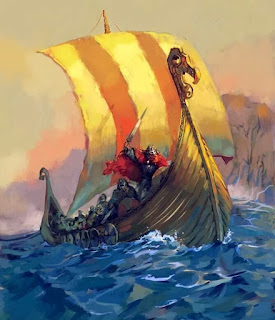Ireland:
The Irish church annals reported of a fleet of sixty long ships on the Liffey carrying 1.500 men, it was led by Saxolb (Soxulfr). The vikings build a fortress at Dublin(Ath-Cleath) in the following years Viking activity kept increasing in Ireland. 120 Viking ships arrived in Dublin.
Netherlands
Frisia was attacked again and on the island Walcheren vikings killed some of the emperors men and robbed more and when they left they demanded taxes and they returned to Dorestad where they also demanded tax. The emperor was on a journey to Rome, but returned as quickly as possible to Nijmegen, only to find out that the vikings were gone, Louis the pious investigated the raids and he found out that the local Frisian leaders were weak or cooperating with the viking raiders. The emperor sent pious abbots and vigilant counts to Frisia.
Viking naval warfare
The Vikings followed their kings or leading aristocrats, and the soldiers was referred to as a hird, or huscarls. The king or jarl (earl) would call out his men for campaign, and the standard period of duty was four months per year. Mercenaries were also employed, and often the Danegeld was collected to pay them, with the rest of the plunder going to the regular soldiers
The smallest unit in the army was the ship’s crew, and the smallest ship allowed was 26 oars. Most ships tended to number between 32 and 50 oars, though the largest ships were probably used for transport nearer home rather than sea journeys. The ship carried the necessary number of soldier/oarsmen and additional troops up to twice that number, although one ship is recorded to have carried 574 men.
The fleets could be just a few ships, depending on the target, but fleets in the scores or hundreds were much more common
The Irish church annals reported of a fleet of sixty long ships on the Liffey carrying 1.500 men, it was led by Saxolb (Soxulfr). The vikings build a fortress at Dublin(Ath-Cleath) in the following years Viking activity kept increasing in Ireland. 120 Viking ships arrived in Dublin.
Netherlands
Frisia was attacked again and on the island Walcheren vikings killed some of the emperors men and robbed more and when they left they demanded taxes and they returned to Dorestad where they also demanded tax. The emperor was on a journey to Rome, but returned as quickly as possible to Nijmegen, only to find out that the vikings were gone, Louis the pious investigated the raids and he found out that the local Frisian leaders were weak or cooperating with the viking raiders. The emperor sent pious abbots and vigilant counts to Frisia.
Viking naval warfare
The Vikings followed their kings or leading aristocrats, and the soldiers was referred to as a hird, or huscarls. The king or jarl (earl) would call out his men for campaign, and the standard period of duty was four months per year. Mercenaries were also employed, and often the Danegeld was collected to pay them, with the rest of the plunder going to the regular soldiers
The smallest unit in the army was the ship’s crew, and the smallest ship allowed was 26 oars. Most ships tended to number between 32 and 50 oars, though the largest ships were probably used for transport nearer home rather than sea journeys. The ship carried the necessary number of soldier/oarsmen and additional troops up to twice that number, although one ship is recorded to have carried 574 men.
The fleets could be just a few ships, depending on the target, but fleets in the scores or hundreds were much more common


No comments:
Post a Comment